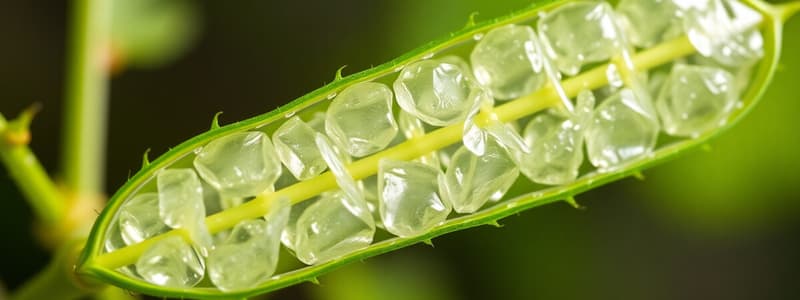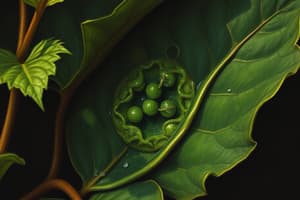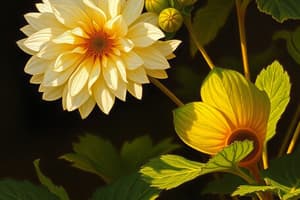Podcast
Questions and Answers
What is the primary role of glucose produced during photosynthesis?
What is the primary role of glucose produced during photosynthesis?
- It is used directly for photosynthesis.
- It serves as a source of energy and can be stored. (correct)
- It is solely released into the atmosphere as oxygen.
- It replaces the need for water in plant cells.
Which statement accurately describes autotrophs?
Which statement accurately describes autotrophs?
- They are organisms that consume other organisms for energy.
- They rely entirely on decomposition for energy.
- They can only derive energy from sunlight directly.
- They produce their own food and store energy compounds. (correct)
In which part of the plant does photosynthesis primarily occur?
In which part of the plant does photosynthesis primarily occur?
- In the roots.
- In the flowers.
- In the stems.
- In the chloroplasts. (correct)
What is the function of light-dependent reactions in photosynthesis?
What is the function of light-dependent reactions in photosynthesis?
What is the difference between light-dependent and light-independent reactions?
What is the difference between light-dependent and light-independent reactions?
What is the primary function of chlorophyll in the chloroplast?
What is the primary function of chlorophyll in the chloroplast?
Which statement accurately describes the function of ATP in photosynthesis?
Which statement accurately describes the function of ATP in photosynthesis?
What is the end product of the light-dependent reactions that exits the chloroplast?
What is the end product of the light-dependent reactions that exits the chloroplast?
Which of the following best describes the structure known as the granum?
Which of the following best describes the structure known as the granum?
Which type of plant maintains its leaves year-round and has needle-like leaf structures?
Which type of plant maintains its leaves year-round and has needle-like leaf structures?
At what temperature do plants typically stop utilizing photosynthesis?
At what temperature do plants typically stop utilizing photosynthesis?
How does NADP+ function in photosynthesis?
How does NADP+ function in photosynthesis?
Which part of the chloroplast is a jelly-like fluid that supports the thylakoids?
Which part of the chloroplast is a jelly-like fluid that supports the thylakoids?
Flashcards
Photosynthesis
Photosynthesis
The process by which plants, algae, and some bacteria convert light energy from the sun into chemical energy stored in glucose (sugar). This process involves using carbon dioxide (CO2) from the air and water (H2O) from the soil.
Autotrophs
Autotrophs
Organisms that can produce their own food (glucose) through photosynthesis. They are the base of all food chains.
Heterotrophs
Heterotrophs
Organisms that obtain their food by consuming other organisms. They cannot make their own food.
Chlorophyll
Chlorophyll
Signup and view all the flashcards
Calvin Cycle
Calvin Cycle
Signup and view all the flashcards
Chloroplast Structure
Chloroplast Structure
Signup and view all the flashcards
Thylakoid Stack
Thylakoid Stack
Signup and view all the flashcards
Light-Dependent Reaction (LDR)
Light-Dependent Reaction (LDR)
Signup and view all the flashcards
Light-Independent Reaction (LIR)
Light-Independent Reaction (LIR)
Signup and view all the flashcards
ATP vs. ADP
ATP vs. ADP
Signup and view all the flashcards
NADP+ vs. NADPH
NADP+ vs. NADPH
Signup and view all the flashcards
Endosymbiont Theory
Endosymbiont Theory
Signup and view all the flashcards
Study Notes
Photosynthesis Overview
- Photosynthesis is the process by which plants convert light energy into chemical energy (glucose).
- The overall reaction is: CO2 + H2O + light energy → glucose + O2.
- CO2 comes from the atmosphere, and H2O from the soil.
- Plants use glucose for energy (ATP) or storage.
- Plants release O2 as a waste product.
- Plants are autotrophs, meaning they make their own food; they form the base of all food chains/webs.
- Heterotrophs consume other organisms for energy.
Chloroplast Structure
- Photosynthesis occurs in chloroplasts.
- Chloroplasts contain thylakoids (membrane-bound sacs with photosynthetic pigment chlorophyll) stacked into grana.
- The stroma is the fluid surrounding the thylakoids.
- Chloroplasts have their own DNA, supporting the endosymbiotic theory.
Light and Photosynthetic Pigments
- Light energy comes from the sun, mimicking it with grow lamps (red and blue light).
- Visible light has different wavelengths, corresponding to colors in the ROYGBIV spectrum (red, orange, yellow, green, blue, indigo, violet).
- Plants primarily absorb red and blue light.
- Green light is not absorbed and reflected, which is why plants appear green.
- Light can be reflected, refracted, or absorbed.
Photosynthesis Stages
- Photosynthesis is a two-stage process: light-dependent reactions and light-independent reactions (Calvin Cycle).
- Light-dependent reactions require light energy, split water, and generate ATP and NADPH.
- Light-independent reactions use ATP and NADPH to synthesize glucose.
- These stages are interdependent.
ATP and ADP
- ATP (adenosine triphosphate) stores energy.
- ADP (adenosine diphosphate) is created when ATP releases energy.
- ATP is essential for many cellular processes, including active transport.
Types of Plants
- Plants in deciduous forests drop leaves to conserve energy when sunlight decreases and water freezes.
- Broad, flat leaves increase sunlight absorption surface area.
- Coniferous forest plants, including pines, keep their leaves year-round.
- Needle-like leaves increase the number of leaves to compensate for the lack of broad surface area.
- The temperature at which plants stop photosynthesis is 0°C/32°F.
Light-Dependent Reactions (LDR)
- LDR requires light energy
- Splits water into hydrogen ions (2H+) and electrons
- Produces O2 as a byproduct.
- NADP+ + H+ + 2e- → NADPH
- The electrons and hydrogen ions are sent to the Calvin Cycle.
Light-Independent Reactions (LIR)/ Calvin Cycle
- LIR (Calvin cycle) does NOT require light energy to run, but uses ATP.
- NADPH provides the electrons and hydrogen ions.
- ATP provides energy.
- Results in synthesis of glucose.
- The ADP and NADP+ produced in this process are sent back to the LDR.
Studying That Suits You
Use AI to generate personalized quizzes and flashcards to suit your learning preferences.
Description
Explore the essential processes of photosynthesis and the structural components of chloroplasts. Understand how plants convert light energy into chemical energy and the role of various pigments in this vital process. This quiz will test your knowledge of plant biology and energy transformation.




